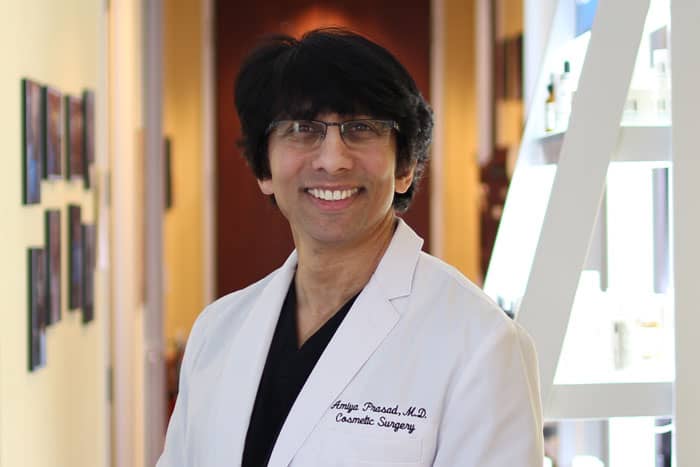Effective Non-Surgical Alternative to Hair Transplant
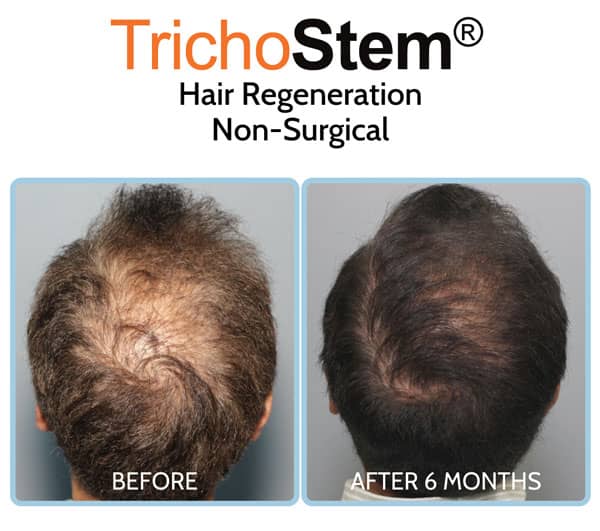
When you search for a solution to hair loss online, you are frequently bombarded with advertisements from hair transplant clinics. For a long time, a certain percentage of people were committed to getting a hair transplant since they had no other options. Fortunately, as a result of my efforts to improve the outcomes of my hair transplant procedures, I created a non-surgical alternative to hair transplantation that has successfully treated patients since 2011. I’ll share my thoughts on this alternative procedure which can for the majority of my patients outperform surgical hair transplants.
Non-Surgical Hair Transplant Alternative: TrichoStem Hair Regeneration Treatment
History
For many years, hair transplant surgery was one of the most popular treatments I did in my practice.
As a cosmetic surgeon, I was accustomed to high levels of happiness with my facial and body cosmetic procedures, but I was frustrated with attaining consistent results and equivalent satisfaction with hair transplant surgery. The two areas on which I wanted to focus were optimizing hair graft survival to increase yield, and improving donor area healing where the strip of hair-bearing skin was taken.
To do this, I used extracellular matrix by the company ACell that I was using to help expedite incision healing for cosmetic surgery, to help heal hair grafts, as well as the donor area. I saw that in addition to increased graft survival, and improvement donor area healing that thinning hair that wasn’t transplanted became thicker. I concentrated my efforts and resources on determining how to best dose, and deliver this treatment for genetic pattern hair loss in men, and women.
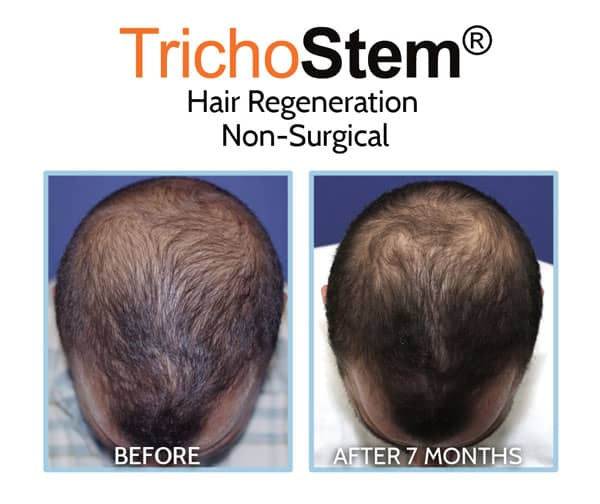
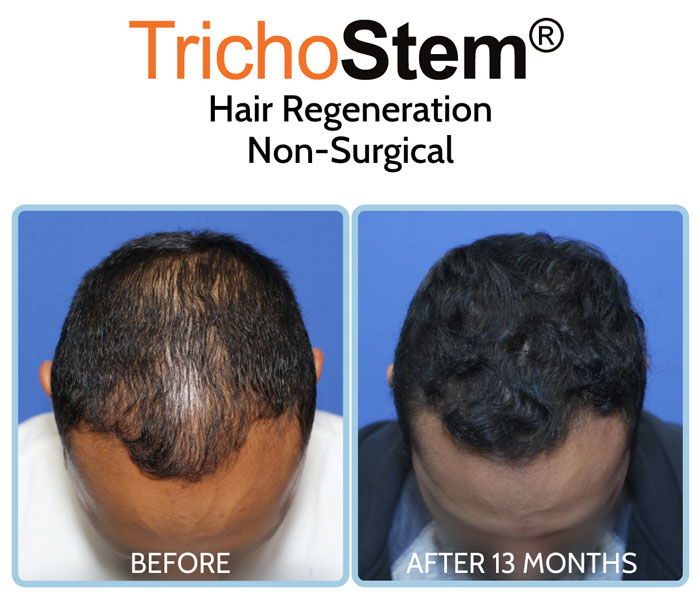
This work took years, but I was eventually able to obtain consistent outcomes for both men and women with androgenetic alopecia with what we now call TrichoStem® Hair Regeneration. We’ve helped clients from all over the world enhance their appearance and confidence in just 1-2 treatment sessions, with a success rate of more than 99%.
Many of my patients who were considering hair transplant surgery decided they didn’t need it after receiving TrichoStem® Hair Regeneration treatment. TrichoStem® Hair Regeneration is without a doubt the industry standard for ACell+PRP treatments, which look to be gaining popularity many years after we invented our procedure.
Why Not Everyone Can’t Get a Hair Transplant
I frequently see individuals who, professionally speaking, were not great candidates for hair transplant surgery yet underwent many surgeries.
These individuals believed that their only option was to get hair transplant surgery. Unfortunately, they fell victim to the strong salesmanship of hair transplant “factories” both in this country, and elsewhere where the cost is far lower.
With few exceptions, I believe that men in their 20s, and women with a diffuse hair thinning pattern should not receive hair transplant surgery. When assessing the incidence of hair loss in men, we apply a broad rule of thumb known as the Rule of Decades. For example, if you are a male in your 20s, approximately 20% of your peers suffer hair loss, whereas 80% do not. If you’re in your 50s, you’re probably aware that half or more of your peers experience hair loss.
When choosing a treatment strategy that includes hair transplant surgery, it is important to evaluate the age of onset and the pace of hair loss. The limited donor area in the rear of the scalp is used to harvest hair for transplantation.
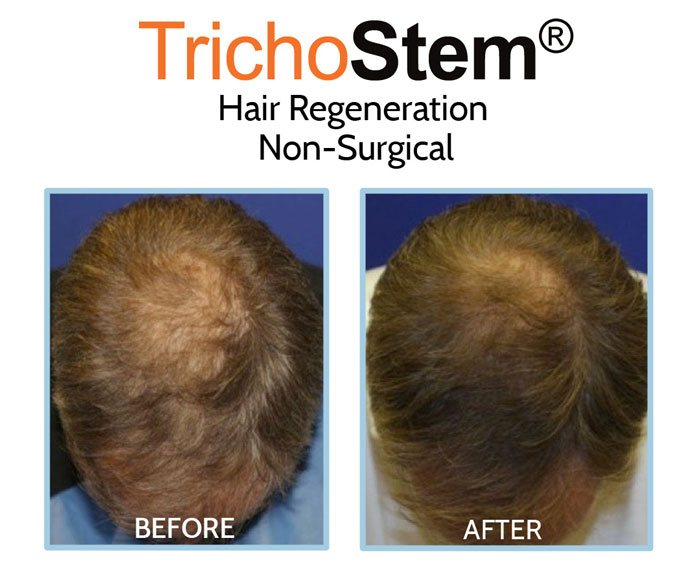
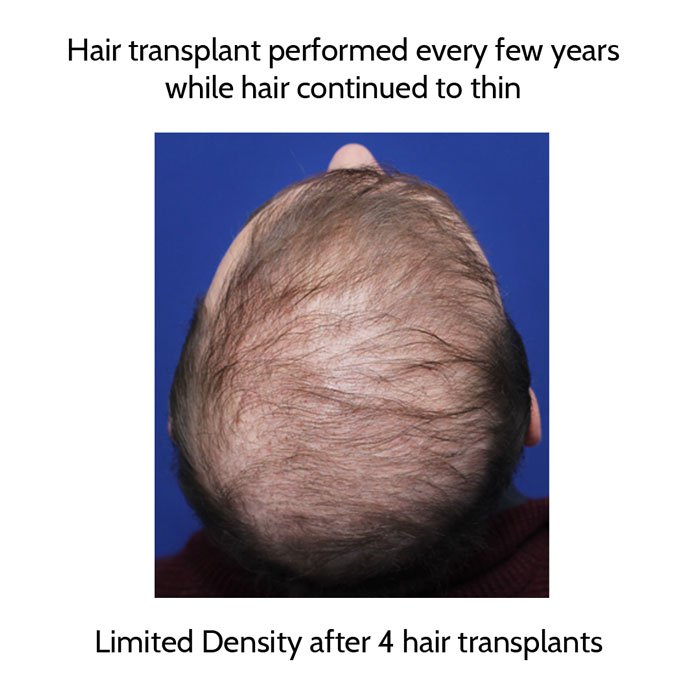
A younger man who has a hair transplant will continue to lose hair at a significantly faster rate due to the nature of his type of hair loss, than a middle-aged man starting to experience hair loss at an older age. This indicates that if transplantation is conducted on a regular basis to address persistent hair loss, the donor area will deplete faster. It’s also crucial to recognize that aesthetic expectations change between younger and middle-aged men. This indicates that no matter how much surgery a younger man undergoes to treat moderate to advanced hair loss, he is unlikely to reach density and coverage equivalent to the 80% of his peers.
Unfortunately, many men who opt to get several transplants in their 20s come to regret their decision when they are in their late 30s. This is because people continue to lose hair, and the hair that remains is transplanted hair, which lacks density and does not appear real.
This type of hair loss is distinguished by diffuse thinning with no areas of smooth non-hair bearing skin. Hair transplant surgery has the potential to exacerbate hair loss in these patients due to the loss of existing hairs as a result of trauma caused by the incisions used to implant hair grafts.
The word for this is collateral damage. For this type of hair loss sufferer, a hair transplant option is critical. As previously indicated, the TrichoStem® Hair Regeneration procedure can be used without the risk of depleting donor hair, or causing collateral hair loss.
TrichoStem® Hair Regeneration: A Customized ACell+PRP Hair Treatment Strategy
I want to also make clear that TrichoStem® Hair Regeneration is not just about the injection treatment, but is rather about a treatment strategy. When I meet with a patient, I develop a customized treatment plan with modalities to optimize hair growth. Pharmaceuticals,and hormonal therapy may also help improve overall results.
TrichoStem® Hair Regeneration increases the number of visible hairs on the scalp by reactivating hair that is not growing, and thickening thinning hair, resulting in significant improvement of scalp coverage.
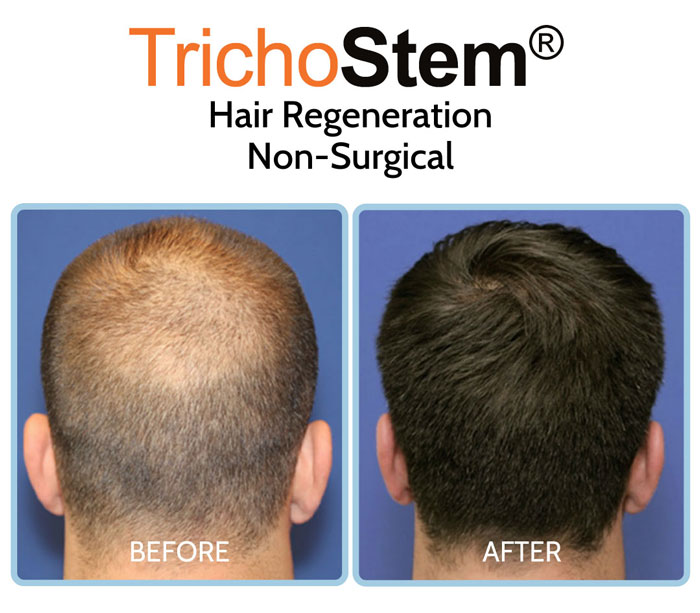
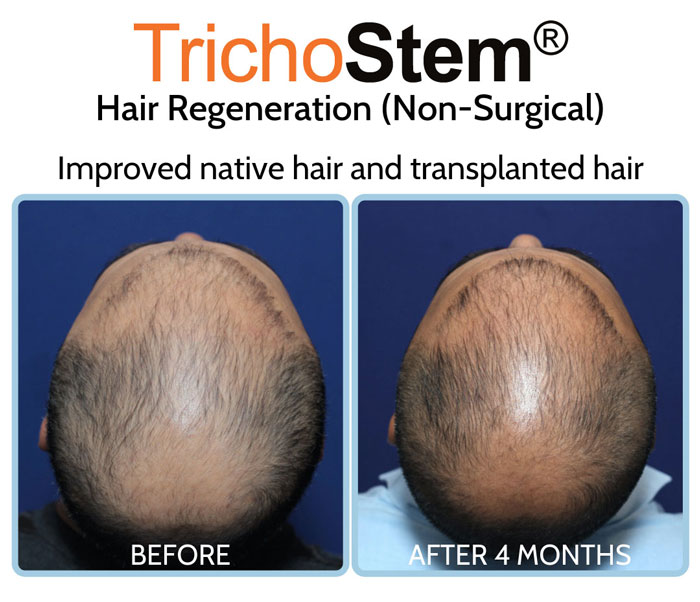
This phenomena is critical to consider while evaluating the technical constraints of hair transplant surgery. Your natural hair, even if it is thinning, can be as dense as 50-100 hairs per square centimeter, which is much higher than the 20 grafts per square centimeter that is safe to transplant.
The Density Dilemma: Understanding Hair Transplant Limitations
With surgical hair transplantation, you will only get about 20 grafts per square centimeter. This is because the skin’s capacity to heal with many incisions for hair grafts is constrained by its structural integrity, and available blood supply. If you insert too many grafts, the skin breaks down and the hair transplants do not survive. For this reason, many patients who have undergone hair transplant surgery are disappointed with how artificial their grafts appear in terms of density, and they are resigned to having to endure another procedure in order to increase their density.
This implies they are paying twice, thus reducing their available donor hair. Whether you are undergoing FUT or FUE surgery, the donor area has a limited amount of hair grafts. To get natural-looking density, you’ll need far more grafts than you can harvest from the back of the scalp. It’s just a surface area mismatch; the top of the scalp is significantly greater than the small patch of hair-bearing skin that is genetically resistant to hair loss.
TrichoStem® Hair Regeneration achieves very effective coverage without surgery by increasing the amount of hairs and thickening existing thinning hair, which is inherently far denser than can be accomplished with a hair transplant.
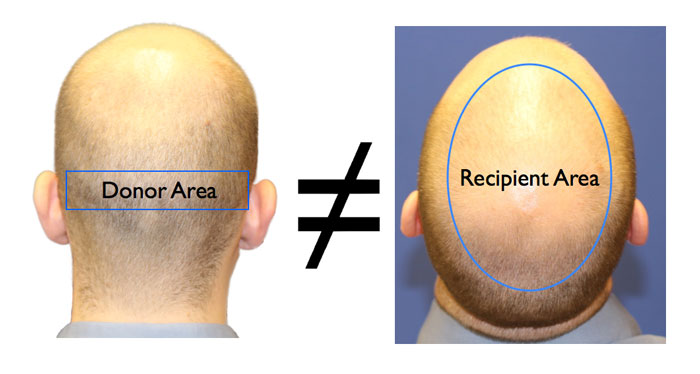
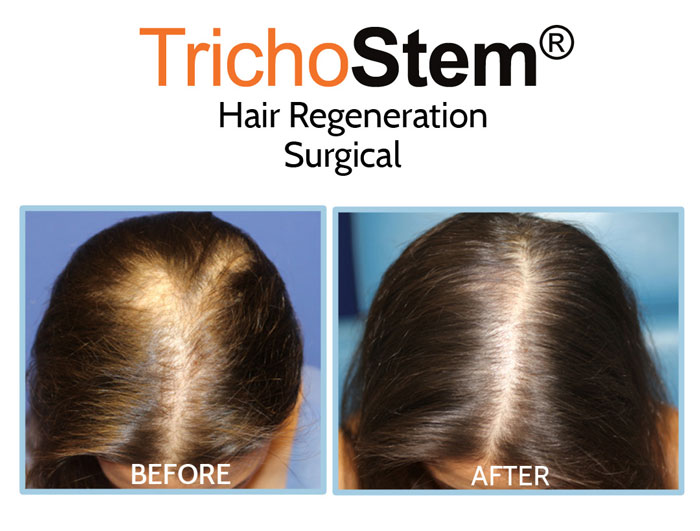
Although the marketing of hair transplants may appear to be attractive, hair transplantation is essentially the movement of hair from one site to another. Unfortunately, a certain percentage of hairs, often up to 90%, do not survive when transplanted from one region to another.
Furthermore, as previously stated, collateral damage to existing hair in the recipient location leads to a significant loss of potential density and coverage despite transplanting. Follicular unit extraction, or FUE, is a common technique with a high transection rate. Transection means that when the hair graft is harvested, a certain percentage (up to 30%) of the hairs lack the root or follicle required for hair to grow when implanted. This indicates that up to 30% of the grafts will not grow hair. In addition, some hair grafts do not survive to grow hair. Every week, I see patients who have undergone three hair transplants and are disillusioned and disheartened by their experience.
Since they are no longer able to have further surgery, they require a new approach to their predicament.
Typically, I can assist patients improve the appearance of their hair grafts, as well as the few remaining native hairs using TrichoStem® Hair Regeneration. In reality, I’ve helped many people with old hair transplants by not only increasing the quality of their transplanted hair, but also reactivating hair that had been transplanted but was not growing.
It is essential to note that hair transplant surgery is quite damaging to the scalp. Consider a surgery that involves 1500 to 2500 stabs in the scalp – scar tissue and vascular impairment can result in a suboptimal environment for hair development. I feel that by employing Acellular matrix and platelet-rich plasma, I am improving the environment by optimizing blood flow, and recruiting your adult stem cells to the deeper layers of the skin, where the hair follicles are located. It is critical to understand that, particularly with treatments like FUE, hair is extracted from locations other than the genuine permanent zone. This means these grafts are subject to thinning just like the hairs that have been lost from the top of the scalp.
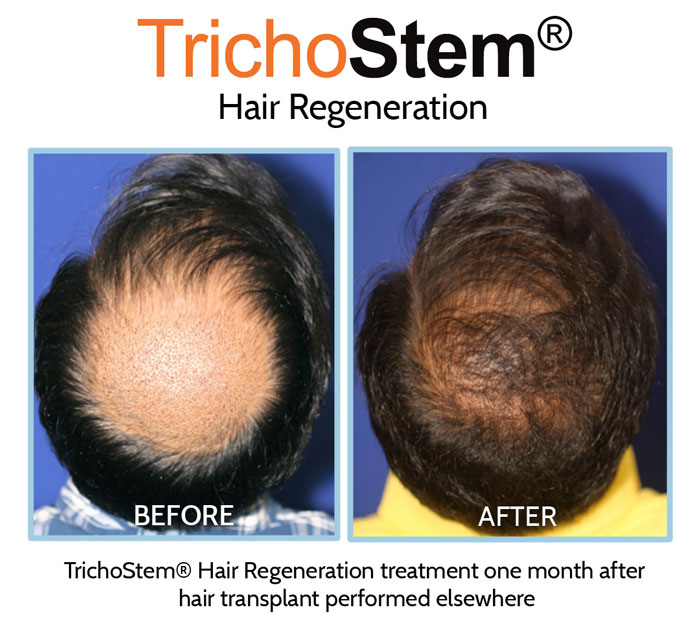
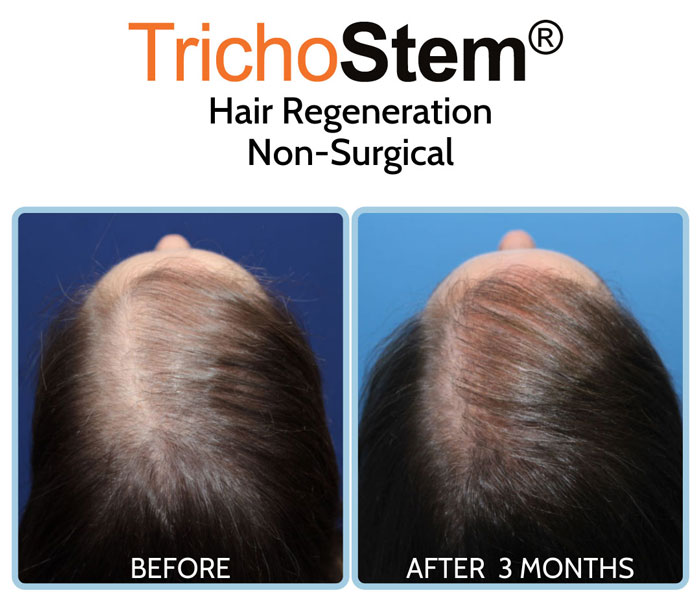
After all of this, does it mean that a hair transplant is never necessary? Of course not; there are situations of advanced hair loss, particularly frontal hair loss, where no viable hair follicles remain to be treated non-surgically. Typically, the same patient who might benefit from frontal hair transplantation also possesses hair in the middle and back of the head. Given that hair transplantation is still severely constrained by the quantity of hairs that may be successfully transplanted and the restrictions of producing natural density, a technique can be implemented in which ideal coverage is attained before the patient undergoes hair transplant surgery.
As can be seen in celebrities who have had an obvious hair transplant, the frontal hairline is defined by natural density with a transition behind the hairline rather than isolated grafts in a picket fence-like pattern. So, my recommendation is to undergo the TrichoStem® Hair Regeneration treatment first to enhance coverage before a surgical hair transplant. Simply said, every hair that we can restore and thicken enables the hair transplant surgeon to concentrate the limited number of grafts to a smaller surface area.
We’ve also assisted several people who had hair transplants and then discovered TrichoStem® Hair Regeneration. I discovered that patients who have had hair transplant surgery can benefit from maximizing both graft and local hair development. I often joke that one year following surgery, the surgeon who performed the transplant will want to take credit for how fantastic they look as a result of the increased density achieved with TrichoStem® Hair Regeneration.
What Can I Do Instead of Hair Transplant?
Although the marketing of hair transplant surgery creates the impression that the only way to address significant hair loss is to have a hair transplant, we have demonstrated since 2011 that a non-surgical treatment such as TrichoStem® Hair Regeneration can not only be comparable, but also produce results that outperform not one, but two hair transplant surgeries.
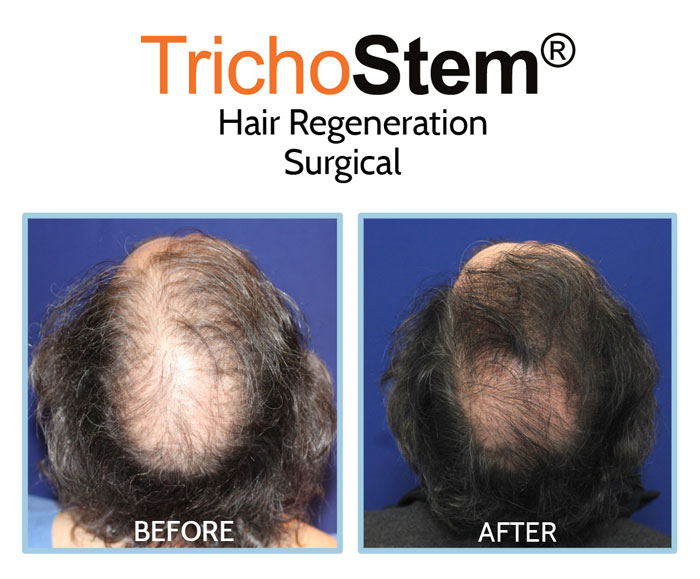
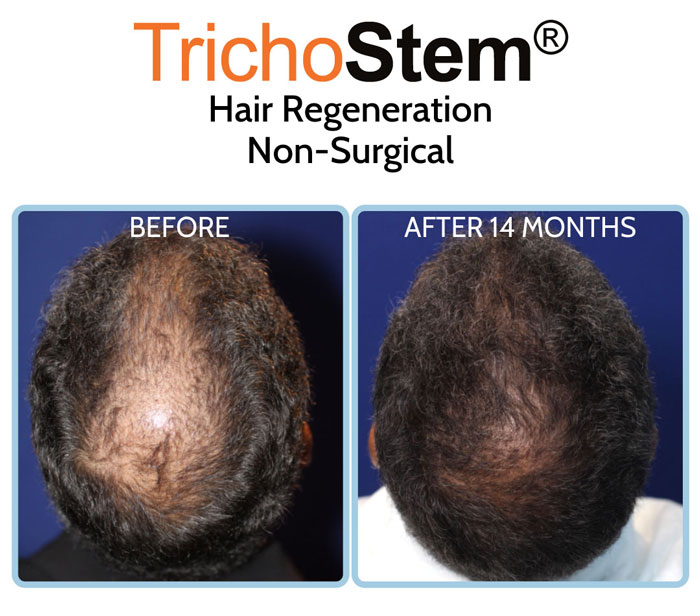
In a transaction-driven market, the long-term effects of any aesthetic operation, such as a laser treatment, cosmetic surgery, or hair transplant, are frequently overlooked.
A patient with hair loss differs from a patient who wants to use Botox for the first time. Hair loss has a tremendous emotional impact, and I believe that people who come to me with hair loss need an honest opinion and a treatment plan, not a transaction. I hope this information was helpful.
Non-surgical Hair Restoration Manhattan, NYC and Long Island, New York
Dr Amiya Prasad is a Board-certified cosmetic surgeon, and a Fellowship-trained oculofacial plastic and reconstructive surgeon. He’s been in practice in New York City, and Long Island for over 25 years, where he performed hair transplant surgery since the early days of medical practice. He eventually developed TrichoStem® Hair Regeneration for hair loss in 2011 and has treated thousands of patients since then from around the world.
If you would like specific recommendations for your case, or guidance for your situation, fill up the form below to schedule a consultation, or call any of our offices at (212) 265-8877 in Manhattan, New York City; (516) 742-4636 in Garden City, Long Island; or (703) 356-1336 in Vienna, Virginia.

